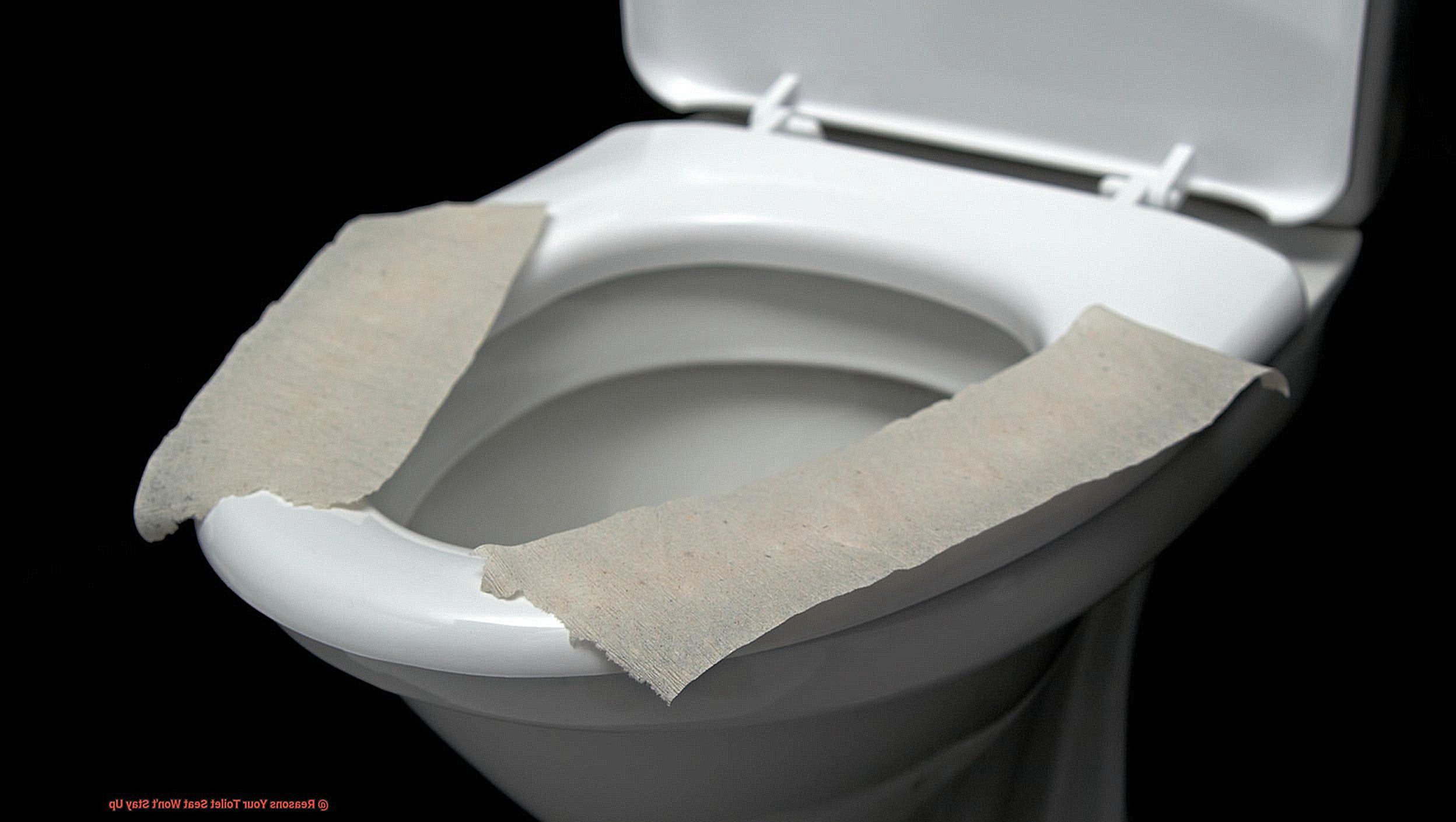When it comes to your bathroom, the last thing you want is a toilet seat that won’t stay up. It’s an inconvenience that can quickly turn into a frustrating and embarrassing situation, especially when you have guests over. But don’t worry; you’re not alone in dealing with this issue.
There are several reasons why your toilet seat won’t stay up, from worn-out hinges to loose or broken bolts. Even the type of toilet seat you have can play a role in this pesky problem. Ignoring it could lead to more significant issues down the line, so it’s crucial to understand what’s causing the issue and how to fix it.
In this blog post, we’ll explore some of the most common reasons why your toilet seat won’t stay up and provide tips on how to fix them. Whether you’re a homeowner or renter, knowing how to keep your toilet seat in place is essential for any bathroom.
By the end of this article, you’ll be well-versed in all things toilet seats and equipped with the knowledge needed to tackle any future issues. So let’s dive into the world of toilets and uncover what’s keeping that seat from staying put.
Contents
What Causes a Toilet Seat Not to Stay Up?

First up, we have the loose or damaged hinge. Think of it like a creaky old door that’s seen better days – over time, the hinges that hold your toilet seat in place can become worn out and wobbly, causing the seat to fall down when you least expect it. To remedy this, try tightening the screws or bolts that hold the hinge in place using a trusty screwdriver or wrench. If that doesn’t work, you may need to replace the hinge entirely.
Another thing to consider is the shape of your toilet bowl. Some toilets have a more rounded front, which can make it difficult for the seat to stay put. In these cases, you may need to switch up your seat game and opt for something with a different shape or even consider upgrading to a different toilet altogether.
The type of material your seat is made of can also play a role in its ability to stay up. Lightweight plastic seats may not be as sturdy as their heavier counterparts made of wood or ceramic, so if you’re dealing with a flimsy seat, it might be worth investing in something sturdier.
And last but not least, we can’t discount user error as a possible factor in your seat’s rebellious behavior. If you’re not lifting the seat all the way up or not positioning it properly before letting go, it may come crashing down on its own. A gentle reminder or two (or three) about proper toilet etiquette can go a long way.
In conclusion, there are several reasons why your toilet seat may not be staying up, but with some detective work and a little elbow grease, you can get it sorted in no time. So go forth, my friend, and enjoy your bathroom breaks without fear of a rogue toilet seat.
Loose Seat Hinge
Firstly, one of the most common causes of a loose toilet seat hinge is frequent use. The screws that hold the hinge in place can become worn or loose over time, causing the entire seat to become unstable. This can lead to discomfort and even potential danger. But fear not, the solution is simple. You can start by tightening the screws that hold the hinge in place, but remember not to overdo it.

Secondly, improper installation can also be to blame. If the hinge was not installed correctly in the first place, it may become loose over time due to regular use. It’s like building a house without a solid foundation, eventually causing it to crumble. To avoid this issue, make sure to follow the manufacturer’s instructions carefully when installing a new toilet seat to ensure that it is secured properly.
Lastly, wear and tear over time can weaken the seat and cause the hinge to become loose. This is especially true if the seat is made of lightweight plastic or another material that is prone to cracking or breaking. It’s like an old pair of shoes that have walked their last mile. In this case, it may be necessary to replace the entire seat rather than just tightening the hinge screws.
Worn-Out Toilet Seat Hinge
If you’ve noticed that your toilet seat wobbles or slides around, it’s likely that the hinges have worn out due to regular wear and tear. But no need to panic. Replacing worn-out toilet seat hinges is a simple DIY task that can be completed in just a few minutes.
To start this easy fix, simply flip open the covers on the back of your toilet seat where the hinges are located. Use a screwdriver to remove the screws holding the old hinges in place, then carefully pull them out of their slots. Next, insert the new hinges into their slots and secure them in place with the screws provided. Voila. Your throne is now stable and secure once again.
But why bother with replacing your toilet seat hinges? Well, for starters, a loose or unstable seat can be an annoying inconvenience. Nobody wants to deal with a wobbly seat or one that won’t stay up on its own. Additionally, a damaged hinge can pose a safety hazard, potentially causing someone to fall off the toilet.
Adjustable Hinges
Adjustable hinges are a must-have feature for modern toilet seats. They allow you to customize the seat to fit your body perfectly, ensuring ultimate comfort and convenience. No more awkward shifting or uncomfortable wobbling – just a perfect fit every time.
But what if your adjustable hinges aren’t working as well as they should be? One common issue is that they can become loose over time due to repeated use. This can cause your toilet seat to wobble or even unexpectedly fall down. But don’t worry – fixing it is easy. All you need to do is tighten the screws that hold the hinges in place. This simple fix will stabilize the seat and prevent any unwanted movements.
If your hinges are damaged or worn out, however, you may need to replace them or even the entire seat. Don’t settle for a subpar replacement – make sure you choose a high-quality seat with sturdy hinges designed to withstand regular use.
Now, if you’re not sure how to adjust or replace your toilet seat hinges, we recommend seeking the help of a professional plumber or handyman. They can provide expert advice and ensure that your toilet seat is properly installed and functioning as it should be.
Replacing the Entire Toilet Seat
Replacing the entire toilet seat may be the solution you need. It’s easy, and with just a few basic tools and simple steps, you can have a brand new toilet seat installed in no time.
Before you begin, it’s essential to measure your existing toilet seat’s size and shape to ensure that you purchase the correct replacement. Once you have your new toilet seat at hand, follow these steps for a seamless installation:
- Step 1: Remove the old seat and hinges. Unscrew the bolts that hold the hinges in place. If they are rusted or corroded, use pliers or a wrench to help loosen them.
- Step 2: Clean the area around the mounting holes with a disinfectant cleaner for a clean surface.
- Step 3: Position your new toilet seat on the bowl and align the mounting holes with those in the bowl. Insert the bolts through the mounting holes and tighten them with a screwdriver or wrench. Be careful not to over-tighten as this can cause damage to both the seat and the toilet bowl.
- Step 4: Attach the hinges to the new seat by inserting them into the holes on either side of the seat and tightening them with screws or bolts. Ensure that they are securely attached, and that the seat can be raised and lowered without any issues.
Replacing your entire toilet seat may seem like an intimidating task, but with these simple steps and proper measurements, it can be done in no time. Say goodbye to a wobbly or stubborn toilet seat, and hello to seamless bathroom experiences.
hv6XfJofl2A” >
Conclusion
To sum up, a toilet seat that won’t stay up can cause frustration and embarrassment, but it’s a prevalent issue with an easy fix. Loose or damaged hinges, the shape of your toilet bowl, and the material of your seat are all potential reasons why your toilet seat may not stay up. It’s crucial to understand what’s causing the problem and how to solve it to avoid more significant issues in the future.
If you’re dealing with a loose hinge, tightening screws or bolts is an excellent first step. However, if this doesn’t work, replacing the hinge entirely may be necessary. If wear and tear have weakened the seat over time, consider replacing the entire seat instead of merely tightening screws.
Modern toilet seats come with adjustable hinges that allow you to customize them for maximum comfort. However, these hinges can become loose due to repeated use. To prevent any unwanted movements, make sure to tighten the screws that hold them in place regularly.
Replacing an entire toilet seat may seem daunting at first glance. Still, by following some simple steps and taking accurate measurements beforehand, it can be a straightforward process.






